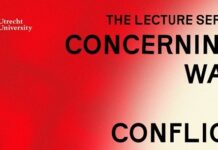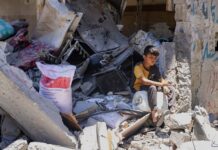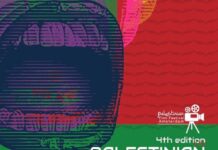Bethan McKernan
The Guardian / October 5, 2024
The artist Maisara Baroud and his family have been displaced 12 times since the start of the Israel-Gaza war. In pictures and words, he describes their journey and the impact of the fighting.
The artist Maisara Baroud never found living in Gaza easy. The Israeli-Egyptian blockade, imposed in 2007 after Hamas’s violent takeover of the territory, was suffocating, and Rimal, his middle-class neighbourhood in Gaza City, had not been spared from airstrikes in the previous wars with Israel.
SEE ILLUSTRATIONS : https://www.theguardian.com/world/ng-interactive/2024/oct/05/it-felt-like-death-was-chasing-us-one-gaza-familys-attempt-to-evade-israeli-strikes-visualised
Despite everything, he said, his family worked hard to establish a simple, quiet existence after being expelled from their village in what is now Israel in 1948. Baroud, 48, was a lecturer in the fine arts department at Al-Aqsa University, and he, his wife, Khansa, 47, and children Rita, 21, Ilya, 18, and Maria, 14, lived in a flat in the large family building shared with his mother, his siblings and their children. A docile cat and several songbirds completed their home life.
A restless sleeper, he liked to draw late at night, after everyone else had gone to bed.
On 7 October 2023, that world collapsed. Following the Hamas attacks in Israel, the war arrived like “an earthquake that ravaged everything … Since that date, our sole mission has become trying to survive,” he said.
Over the past year, Baroud and his family have been displaced 12 times. Nowhere in Gaza is safe from airstrikes, but encroaching Israeli ground forces have forced them to flee again and again. Each move is more difficult than the last, as options and space in already overcrowded areas dwindle.
His story, and his journey, is a window into the new reality of life in the strip, where 90% of the population have fled their homes – many, like the Baroud family, several times – in a war that shows no sign of stopping.
Throughout it all, the artist has managed to keep drawing. Sometimes pens and paper are in short supply, and sometimes he is too exhausted from hours searching for water and food each day, but when he can he documents what his family has witnessed. He calls the series Still Alive, a way to keep communicating with the outside world.
Baroud’s work has always drawn on the hardships of life in Gaza, a black and white palette reflecting a grey city, where characters weave in and out of claustrophobic spaces. Now it is a record of a year of displacement, chaos and pain: aid packages that fall into the sea, tents that fail to protect from either cold or heat, hospitals that become killing zones.
“The killing machine took everything, but could not take away my passion and love for drawing,” he said.
“I draw to document the events and scenes we are living through … destruction, death, sorrow, siege, patience, resilience, defeat. All of these stories are important, like pieces of a mosaic, creating the overall picture.”
The family have narrowly escaped death several times. On the third day of the war, a neighbour ran down the road telling everyone to get out because the Israeli military had called to say an airstrike was coming – a “knock on the roof” practice the Israel Defense Forces (IDF) have long since abandoned. The first missile damaged all six buildings on the street, leaving the artist’s house still standing, but uninhabitable. The second, however, reduced his home, office and studio to rubble.
After spending the night at a neighbour’s, the Barouds left for his sister’s house in Tel al-Hawa, in the south of Gaza City, where 25 family members squeezed into one flat. The next day, the group decided to follow the Israeli order to evacuate the city.
“They said the south was safe … but the tanks and planes have destroyed everything. My dreams, my wife’s dreams, my children’s dreams, and my small world … Everything has ended. There is no future here. There is only death,” he said.
It is almost impossible to imagine now, but a year ago, the Gaza Strip was relatively quiet. Most of the rebuilding from the last war between Hamas and Israel, in May 2021, had been completed. A new work visa system for men from Gaza to enter Israel was making a significant difference, bringing in upwards of $1m a day to the impoverished Mediterranean territory, home to 2.2 million people.
The West Bank, the other occupied Palestinian territory, had seemed more likely than Gaza to descend into war: in response to a rise in attacks on Israeli civilians, the IDF was conducting near-nightly raids on Palestinian militant groups, the worst violence in the area for 20 years.
Unbeknownst to everyone – including Israel’s vaunted intelligence services – Hamas’s military chief, Yahya Sinwar, was planning an offensive designed to upend the status quo of seemingly endless occupation, increasingly normalised by the outside world.
Hamas broke out of Gaza at dawn on 7 October, massacring 1,200 people, the majority of whom were civilians, and seizing another 250 as bargaining chips, according to Israeli tallies.
With echoes of the US in the aftermath of 9/11, Israel’s grief and fury following 7 October has fuelled what the prime minister, Benjamin Netanyahu, calls “total war” on Gaza. The result has been total destruction.
“Everything I knew is gone,” Baroud said. “You walk through some streets and neighbourhoods thinking really hard about the location and trying to identify the buildings, but nothing in Gaza resembles your memory now. It is all blurred and distorted.”
After a year of war, the Gaza in which Baroud was born and grew up no longer exists. By many measures, Gaza is already the bloodiest and most destructive conflict of the 21st century.
The figures are staggering. According to the health ministry in the Hamas-run territory, more than 41,000 people have been killed, about 2% of the population. Though the ministry does not distinguish between militant and civilian deaths, the majority of a recently published list covering 80% of Palestinians killed can be identified as civilians based on age and gender alone.
It is unclear how many more bodies lie under the rubble of collapsed buildings or have died from disease or illness since. The war has also created a generation of orphans. The UN put the number of children without mothers at 19,000 in April, and other estimates run as high as 25,000.
About 92,000 people have been injured, a number including approximately 14,000 new amputees. Anaesthetics, painkillers and prostheses are lacking owing to Israeli blocks on aid that even agencies in the US, Israel’s closest ally, describe as “arbitrary denial, restriction and impediments”.
As of September, about 84% of Gaza is covered by Israeli evacuation orders, forcing 2 million people into overcrowded, unsanitary conditions in areas Israel has designated as “humanitarian zones” – which have been repeatedly bombed anyway.
More than 70% of housing stock has been damaged, along with countless other public buildings, businesses, schools and hospitals. A total of 42m tonnes of debris lies across the territory, the UN says. Clearing the rubble, which contains human remains and unexploded ordnance, then rebuilding, could take 80 years, and cost more than $80bn.
Yet Baroud and his family, along with millions of others, must try to find shelter and safety amid the ruins.
“As a family, we managed to stay together. In some places, the situation on the ground allowed us only hours to stay, while others were relatively safe, far from tank shells but never far from airstrikes and drones,” he said.
After leaving Gaza City on 13 October, the family walked to al-Qarara, north of Khan Younis, seeking refuge in a relative’s house, until it became too crowded with displaced people and they managed to find another flat nearby.
After the week-long ceasefire collapsed on 1 December, ground fighting resumed with a vengeance, and Israeli forces began moving towards central Gaza.
“On that difficult night, we headed to Khan Younis, thinking we had found our final stop, but we were wrong. Within 24 hours, things took a turn for the worse and the area became dangerous, surrounded by fire, forcing us to go to Rafah,” Baroud said.
Rafah, the southernmost point of the strip, would be safest, the family reasoned: the Israelis could not attack an area where more than a million civilians had fled. They were wrong.
Baroud’s sister managed to find an empty shop in the city, where the 25 members of the family packed inside like sardines. But the bombing was still so close that clouds of dust and dirt clouded their vision and tore at their throats.
A few days later, a distant relative found the group a flat close to some aid warehouses, and a month later, they managed to rent in a building in central Rafah. Before the war, the rent would have been about $200; now it was $2,000. Pens and paper are 10 times more expensive than before.
When Israel’s ground assault on Rafah began in May, they were forced back to al-Qarara. “We returned to find it ravaged by tanks, missiles, most of it destroyed, the landscape disfigured,” Baroud said.
“We searched for a long time but could not find a place, so we were forced to live in a destroyed house. We managed to repair parts of it, and after a lot of effort, it was usable.
“It overlooked the smoke from the war in all directions. We slept to the sound of gunfire and woke up to the sound of artillery and tank shells. Death came close many times, but when the tanks came back we were forced to evacuate again.”
In mid-August, unable to find anywhere to stay, the family lived on the street in Deir al-Balah for a week before the ground fighting followed them.
The family went back to their semi-destroyed shelter in al-Qarara a month ago, where Baroud is still drawing during his long, sleepless nights. His shapes have become sharper, more rigid; bodies that curve, bend, break and tremble.
He said he would not leave a third time. The former agricultural area was relatively quiet, and the family could not afford to pay any more rent or risk becoming homeless again.
“It felt like death was chasing us everywhere we went,” he said. “We decided to return to al-Qarara and stay there. Death there has a more acceptable form.”
The artist said he would draw until the war ended, or death claimed him, whichever came first.
Bethan McKernan is Jerusalem correspondent for The Guardian












